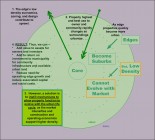Seeking the Market
– Fundamental cause missing in sprawl literature – – Fixed assets in changing markets – – Chronic sprawl is in part market inefficiency – – Development processes and techniques contribute to sprawl – – Solution is pre enabling densification – – Many factors said to cause sprawl might be considered demand generators – – Excessive sprawl is not responsive to the market – – Implications of business as usual? Another generation of development that will contribute to sprawl – . The sprawl conversation does not include a fundamental cause, which is the fixed nature of real estate assets and their relationship to evolving host markets. . Coevolution is Needed in Key Locations The inception of the problem is that…
Planned Densification
I’m pleased to share another article in Urban Land…“Systematic Density for Dummies: Arrested Development Generates Losses That Accrue.” Markets change. Buildings don’t. They could. Some should. This article is a revised and updated version (with a touch of humor) of my 2009 Urban Land article that explores the issue of asynchrony—which happens when fixed-assets and project feasibilities are out-of-sync with their host markets as demand and values change. You can read the 2009 version here: With this 2023 update, I acknowledge real estate development’s challenge of limited functional control of industry processes as a constraint from achieving better outcomes for the public and private sectors. Many betterment programs—such as urbanism, smart growth, the 15 minute…
Azusa Street & SpiritWalk Report
By Mark Smith – Our Azusa Street & SpiritWalk report is a strategic plan for cultural assets in downtown Los Angeles. The report presents tactics to achieve goals of cultural preservation, historical exposition, artistic expression, urban placemaking, entrepreneurship, and economic development. The Azusa Street & SpiritWalk report has been funded by the U.S. Economic Development Administration, the Tom Bradley Legacy Foundation at UCLA, and the Little Tokyo Service Center. Summary of Azusa Street & SpiritWalk Report Azusa Street & SpiritWalk Report
Asynchrony and the Mechanics of Sprawl

By Mark Smith – Markets Change, Buildings Don’t. They Could. Some Should. In many development circumstances, first construction maximizes development potential based upon financial feasibility or highest and best use at that time. But this often occurs at a time when a local market is in a low activity, low value phase of its life cycle—such as in suburban edge areas and the beginning of urban redevelopment. Low sales prices or lease rates generally limit construction types to low density, because high density construction is more expensive and not feasible. Once designed, entitled, financed, and occupied, buildings and their obligations have lives of 20 to 80 or more years, a long-term commitment. …
Let’s Pre-Plan Density…So That We Can Accomplish It
By Mark Smith — Planned Densification is a process to overcome property-level economic obstacles to accomplishing higher density real estate development. Because of high overall construction costs, decreasing market prices, and troubled municipal finances—higher density development is now getting more difficult to accomplish at a time when density is increasingly important for economic development and environmental preservation. “Markets Change, Buildings Don’t” The Problem: In-Place Construction Being Out-of-Sync with Surrounding Markets Especially in key locations, there is an entire layer economic and environmental value that is now lost because of the value and timing relationship between in-place construction and its surrounding market. (Please see a blog post about Asynchrony for a graphic description.) Most new construction…
The New Proforma — After the Collapse
By Mark Smith Urban development entered a new era in the mid 1990s as consumers and developers began to embrace higher density development in urban locations. This is an important trend that promises better ecological outcomes and better economic outcomes for both municipalities and consumers. However, the current economic recession poses a problem relative to the much-heralded urban renaissance. The problem is in what I’ll call the New Proforma, which is facing a ‘new balance’ between costs and revenues. During most of the approximately ten-year urban renaissance, construction costs were relatively low, even for the newly embraced mid-rise buildings and their accompanying parking structures. And while construction costs were relatively low, compared with today, the…

